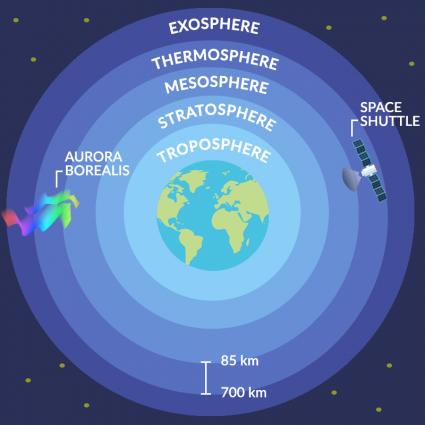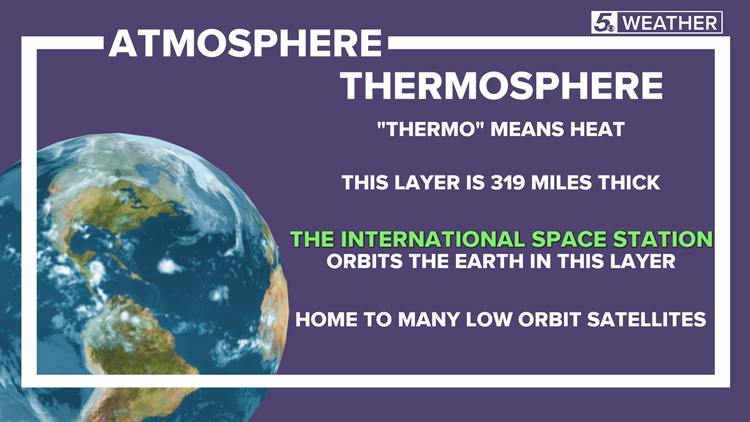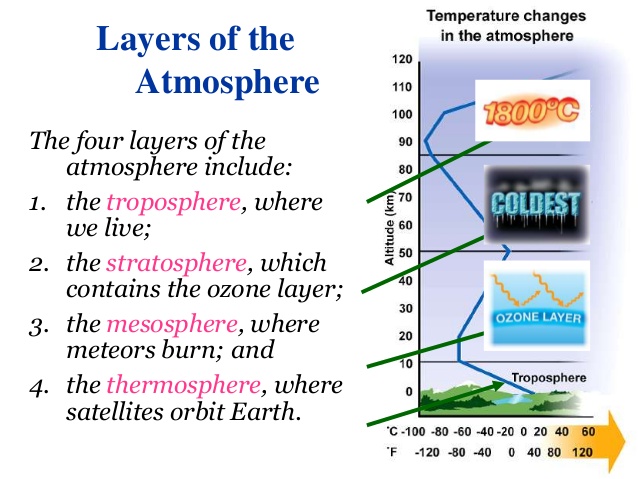
Our results thus suggest that the MTM is yet another phenomenon driven by dynamical links between the lower and upper atmosphere and ionosphere. meteorological astronomical phenomena that occur in the layer of Earths atmosphere. Possible mechanisms generating this wave may involve nonlinear interactions between other tidal harmonics originating in the middle and lower atmosphere. The thermosphere extends from approximately 81 to 500 kilometers above. Although some experts consider the thermosphere to be the uppermost layer of our atmosphere, others consider the exosphere to be the actual 'final frontier' of Earth's gaseous envelope. Its spectrum expands to higher-order zonal wavenumbers and frequencies and its phase advances to near midnight higher up in the thermosphere. Temperatures in the upper thermosphere can range from about 500 C (932 F) to 2,000 C (3,632 F) or higher. Preliminary analysis indicates that the feature may be traced down to the lower thermosphere, where it is manifested primarily in the form of an upward propagating terdiurnal tidal wave.

First long-term simulations with the Whole Atmosphere Model WAM reveal the presence of a realistically prominent MTM and reproduce the salient features of its daily, seasonal, and latitudinal variability. Although several mechanisms have been suggested to explain the phenomenon, previous attempts to reproduce it with comprehensive thermosphere-ionosphere models have been unsuccessful. The thermosphere is one of the 5 layers of the atmosphere, situated above the mesosphere and below the exosphere at an altitude of 90 km (56 miles) to.

The ozone layer lies in the Stratosphere.Abstract: Discovered almost four decades ago, the midnight temperature maximum MTM with typical magnitudes of 50-100 K has been regularly observed by satellite and ground-based instruments in the tropical upper thermosphere. on details, or on phenomena that do not have global or broad impacts. However, Earths auroras the aurora borealis (northern lights) and aurora australis (southern lights)sometimes occur in the lower part of the exosphere, where they overlap into the thermosphere. Journal of the Meteorological Society of Japan, Vol. Thus, we can say that almost all known weather phenomena take place in the troposphere. When we examine the layers of the atmosphere, we find that the layer which contains all these factors is the troposphere. Note Layers of the atmosphere moving upward from ground levels are Troposphere, Stratosphere, Mesosphere, Thermosphere, and Exosphere or Ionosphere. The exosphere is too far above Earth for meteorological phenomena to be possible. As we know, weather phenomena are caused due to the changes in the concentration of water vapour in air, and also due to air currents. The troposphere gets most of its heat through energy transfer from the surface. It contains most of our weather - clouds, rain, snow. This is the lowest part of the atmosphere - the part we live in. Because there are relatively few molecules and. A further region, beginning about 500 km above the Earth's surface, is called the exosphere. Temperatures in the upper thermosphere can range from about 500 C (932 F) to 2,000 C (3,632 F) or higher. We live at the lowest part of the troposphere where all the weather phenomena that we are familiar with take. The amount of water vapor in the atmosphere also decreases with an increase in latitude and increase in height because warm air close to the earth’s surface can hold more water vapor. These layers are the troposphere, the stratosphere, the mesosphere and the thermosphere. opposite phenomenon is called an inversion. The height of the Troposphere extends up to around 10km but it varies with season and change in latitude i.e., lowest at the poles and highest at the equator. The boundary between these two is called Tropopause. Very few cloud formations happen in the Stratosphere, the layer above the Troposphere. Definition The highest layer of the Atmosphere above the Mesosphere extending from approximately 90km above the surface to 10000km where it gradually merges. That is why most types of cloud formation happens in the Troposphere, the lowermost layer of the atmosphere. We can say that this layer is the wettest layer of the atmosphere with 99 percent of its water vapors. The layer that is closest to the earth’s surface contains most of the atmosphere’s mass (about 75-80 percent) and almost all of its moisture.

So, these phenomena can only happen in the layer which can fulfill these preconditions.Ĭomplete step-by-step solutionClose to the earth’s surface, the air is heaviest because of high air density which decreases with an increase in altitude. Air density and water vapor are a must to drive these phenomena along with the temperature range in which water can exist in liquid form. Hint For weather and climate phenomenon to happen, a few conditions should be fulfilled.


 0 kommentar(er)
0 kommentar(er)
